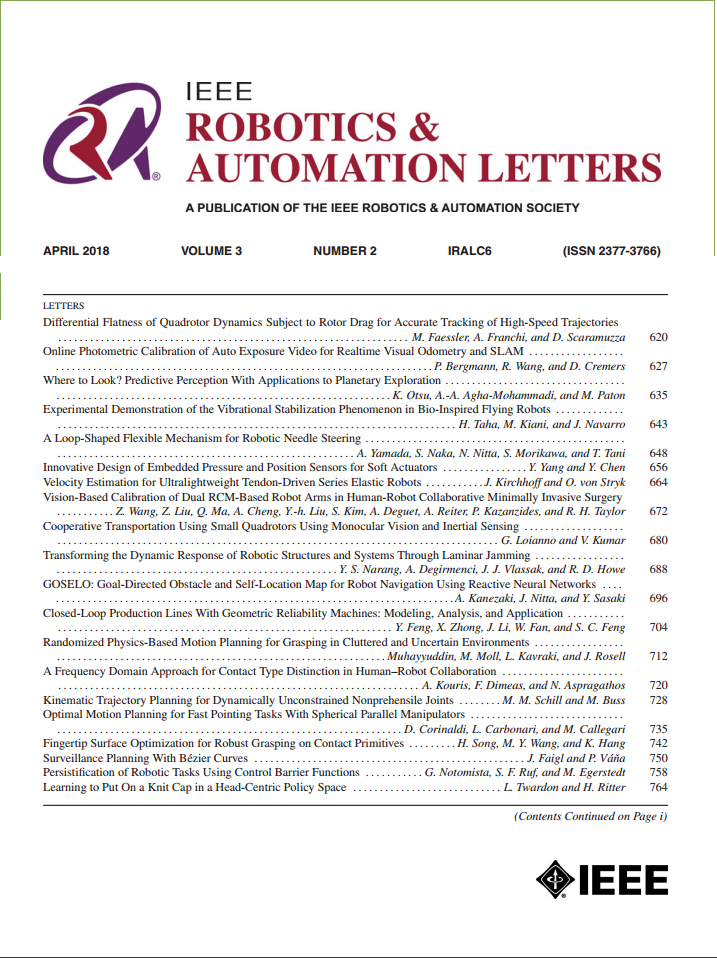On-line Shape Estimation for Hysteresis Compensation in Tendon-Sheath Mechanisms Using Endoscopic Camera
IF 4.6
2区 计算机科学
Q2 ROBOTICS
引用次数: 0
Abstract
The tendon-sheath mechanism (TSM) has significantly advanced both robotic systems and minimally invasive surgery (MIS) by enabling flexible and precise movement through narrow and tortuous paths. However, the inherent flexibility of TSM introduces nonlinear behaviors which depend on its geometrical shape and applied forces, making accurate control challenging. Furthermore, the shape dependency becomes critical in endoscopic robots, where the geometrical shape varies and is not directly visible, limiting the applicability of existing distal sensorless compensation methods. To address the geometry identification problem of TSM, this paper proposes an approach that utilizes real-time visual input from an endoscopic camera for on-line calibration of the TSM's physical model. By introducing the concept of the ‘Equivalent Circle,’ complex shapes of TSMs are simplified, enabling the estimation of their equivalent geometry without direct observation or measurement. Simulation results validate the equivalent circle model, demonstrating minimal deadband percentage errors despite larger discrepancies in equivalent radii across varied configurations. On-line calibration experiments achieved a percent error of 1.38% (±2.92%) for accumulated curve angles and 2.32% (±3.08%) for equivalent radii, demonstrating the method's reliability in shape estimation across varying conditions. In prediction and feedforward experiments, leveraging the equivalent circle to compensate for deadband in arbitrarily shaped TSMs resulted in a maximum trajectory error of 0.25 mm and an RMSE of 0.09 mm. This approach advances distal sensorless control, improving the operational accuracy and feasibility of endoscopic surgical robots under varying geometrical and force conditions.基于内窥镜的肌腱鞘机构迟滞补偿在线形状估计
腱鞘机构(TSM)能够在狭窄曲折的路径上灵活而精确地移动,极大地推动了机器人系统和微创手术(MIS)的发展。然而,腱鞘机构固有的灵活性带来了非线性行为,这种行为取决于腱鞘机构的几何形状和作用力,使得精确控制具有挑战性。此外,形状依赖性在内窥镜机器人中变得至关重要,因为内窥镜机器人的几何形状会发生变化,而且无法直接看到,这就限制了现有的远端无传感器补偿方法的适用性。为了解决 TSM 的几何形状识别问题,本文提出了一种方法,利用内窥镜摄像头的实时视觉输入对 TSM 的物理模型进行在线校准。通过引入 "等效圆 "的概念,TSM 的复杂形状得以简化,从而无需直接观察或测量就能估算其等效几何形状。模拟结果验证了等效圆模型,尽管不同配置的等效半径差异较大,但死区百分比误差极小。在线校准实验中,累计曲线角度的百分比误差为 1.38% (±2.92%),等效半径的百分比误差为 2.32% (±3.08%),证明了该方法在不同条件下进行形状估计的可靠性。在预测和前馈实验中,利用等效圆补偿任意形状 TSM 的死区,最大轨迹误差为 0.25 毫米,均方根误差为 0.09 毫米。这种方法推进了远端无传感器控制,提高了内窥镜手术机器人在不同几何和力条件下的操作精度和可行性。
本文章由计算机程序翻译,如有差异,请以英文原文为准。
求助全文
约1分钟内获得全文
求助全文
来源期刊

IEEE Robotics and Automation Letters
Computer Science-Computer Science Applications
CiteScore
9.60
自引率
15.40%
发文量
1428
期刊介绍:
The scope of this journal is to publish peer-reviewed articles that provide a timely and concise account of innovative research ideas and application results, reporting significant theoretical findings and application case studies in areas of robotics and automation.
 求助内容:
求助内容: 应助结果提醒方式:
应助结果提醒方式:


